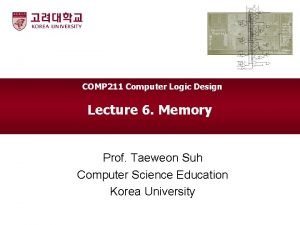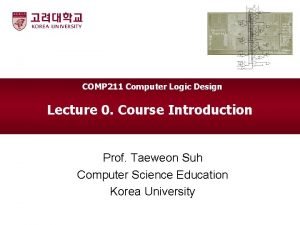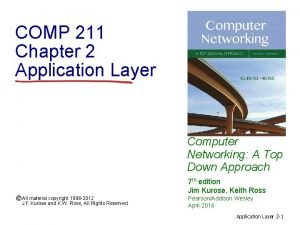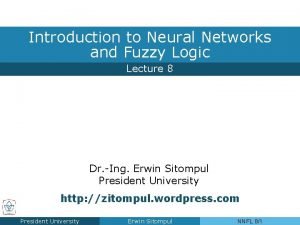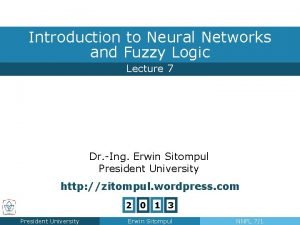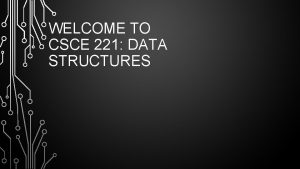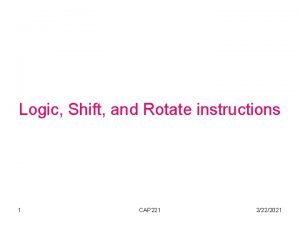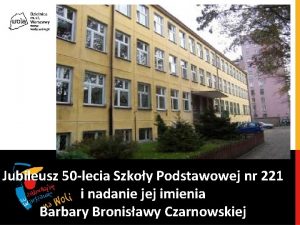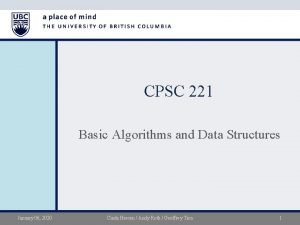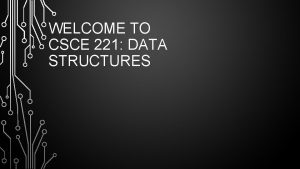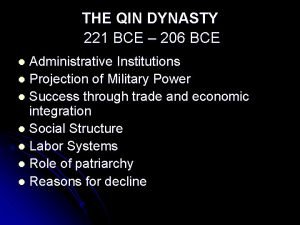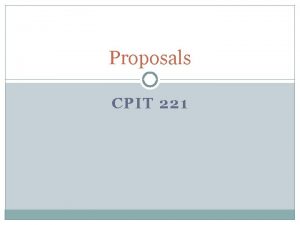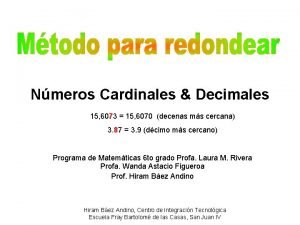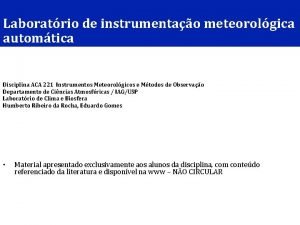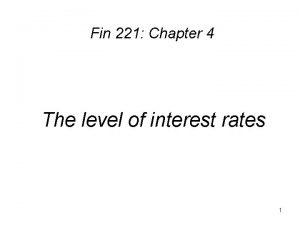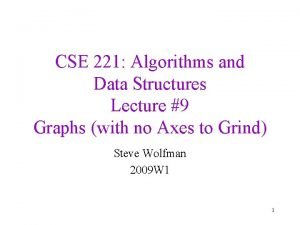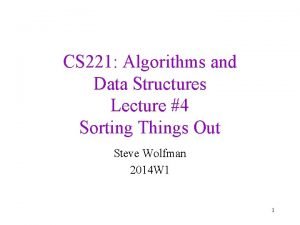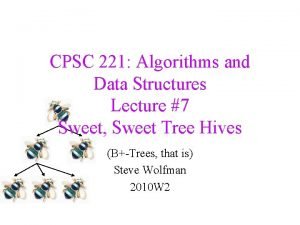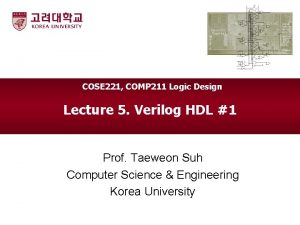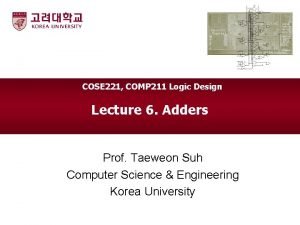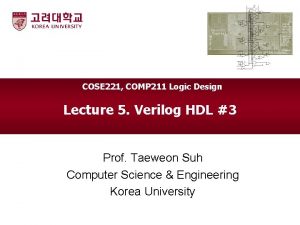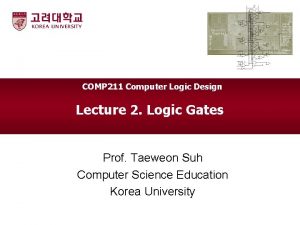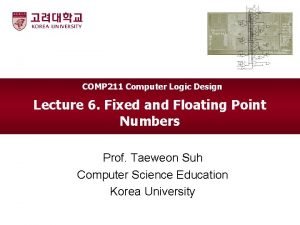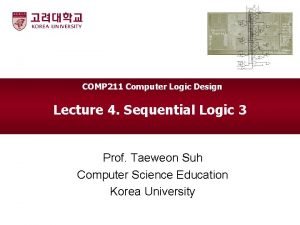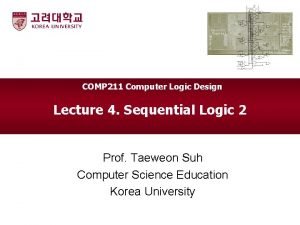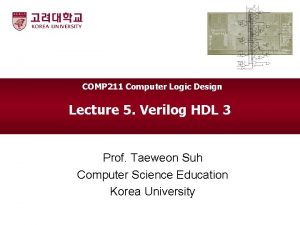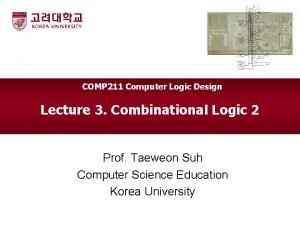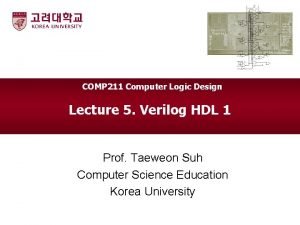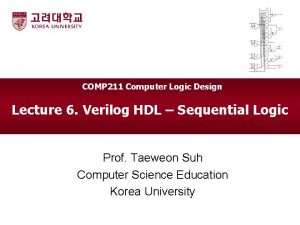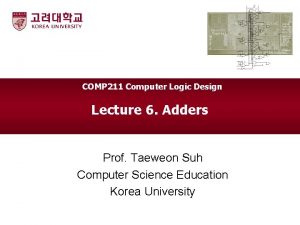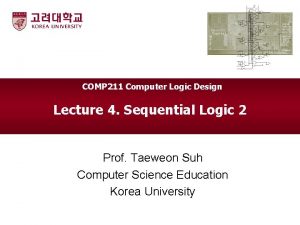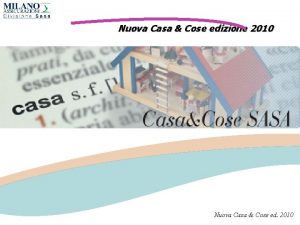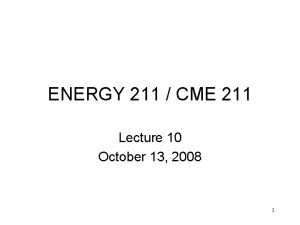COSE 221 COMP 211 Logic Design Lecture 1

































![Number System Comparison Number System Range Unsigned [0, 2 N-1] Sign/Magnitude [-(2 N-1 -1), Number System Comparison Number System Range Unsigned [0, 2 N-1] Sign/Magnitude [-(2 N-1 -1),](https://slidetodoc.com/presentation_image_h2/95766849a1476e323a38be26261ce960/image-34.jpg)
- Slides: 34

COSE 221, COMP 211 Logic Design Lecture 1. Number Systems Prof. Taeweon Suh Computer Science & Engineering Korea University

A Desktop Computer System (as of 2008) CPU Main Memory (DDR 2) FSB (Front-Side Bus) North Bridge Graphics card Peripheral devices DMI (Direct Media I/F) Hard disk USB South Bridge PCIe card • The term “Processor” is used to refer to CPU 2 Korea Univ

A Computer System • Computer is composed of many components CPU (Intel’s Core 2 Duo, AMD’s Opteron etc) Memory (DDR 3) Chipsets (North Bridge and South Bridge) Power Supply Peripheral devices such as Graphics card and Wireless card § Monitor § Keyboard/mouse § etc § § § 3 Korea Univ

Digital vs Analog Digital music A-to-D video wireless signal D-to-A 4 Korea Univ

Bottom layer of a Computer • Each component inside a computer is basically made based on analog and digital circuits § Analog • Continuous signal § Digital • Only knows 1 and 0 5 Korea Univ

What you mean by 0 or 1 in Digital Circuit? • In fact, everything in this world is analog § For example, sound, light, electric signals are all analog since they are continuous in time § Digital circuit is a special case of analog circuit • Power supply provides power to the computer system • Power supply has several outlets (such as 3. 3 V, 5 V, and 12 V) 6 Korea Univ

What you mean by 0 or 1 in Digital Circuit? § Digital circuit treats a signal above a certain level as “ 1” and a signal below a certain level as “ 0” § Different components in a computer have different voltage requirements • CPU (Core 2 Duo): 1. 325 V • Chipsets: 1. 45 V • Peripheral devices: 3. 3 V, 1. 5 V Note: Voltage requirements change as the technology advances 1. 325 V “ 1” Not determined “ 0” 0 V time 7 Korea Univ

Number Systems • Analog information (video, sound etc) is converted to a digital format for processing • Computer processes information in digital • Since digital knows “ 1” and “ 0”, we use different number systems in computer § Binary and Hexadecimal numbers 8 Korea Univ

Number Systems - Decimal • Decimal numbers § Most natural to human because we have ten fingers (? ) and/or because we are used to it (? ) § Each column of a decimal number has 10 x the weight of the previous column • Decimal number has 10 as its base ex) 537410 = 5 x 103 + 3 x 102 + 7 x 101 + 4 x 100 § N-digit number represents one of 10 N possibilities ex) 3 -digit number represents one of 1000 possibilities: 0 ~ 999 9 Korea Univ

Number Systems - Binary • Binary numbers § Bit represents one of 2 values: 0 or 1 § Each column of a binary number has 2 x the weight of the previous column • Binary number has 2 as its base ex) 101102 = 1 x 24 + 0 x 23 + 1 x 22 + 1 x 21 + 0 x 20 = 2210 § N-bit binary number represents one of 2 N possibilities ex) 3 -bit binary number represents one of 8 possibilities: 0 ~ 7 10 Korea Univ

Power of 2 • • 20 21 22 23 24 25 26 27 • • = = = = 11 28 = 29 = 210 = 211 = 212 = 213 = 214 = 215 = Korea Univ

Power of 2 • • 20 21 22 23 24 25 26 27 = = = = • • 1 2 4 8 16 32 64 128 28 = 256 29 = 512 210 = 1024 211 = 2048 212 = 4096 213 = 8192 214 = 16384 215 = 32768 * Handy to memorize up to 29 12 Korea Univ

Number Systems - Hexadecimal • Hexadecimal numbers § Writing long binary numbers is tedious and error-prone § We group 4 bits to form a hexadecimal (hex) • A hex represents one of 16 values § 0, 1, 2, 3, 4, 5, 6, 7, 8, 9, A, B, C, D, E, and F § Each column of a hex number has 16 x the weight of the previous column • Hexadecimal number has 16 as its base ex) 2 ED 16 = 2 x 162 + E (14) x 161 + D (13) x 160 = 74910 § N-hexadigit number represents one of 16 N possibilities ex) 2 -hexadigit number represents one of 162 possibilities: 0 ~ 255 13 Korea Univ

Number Systems Hex Number Decimal Equivalent Binary Equivalent 0 0 0000 1 1 0001 2 2 0010 3 3 0011 4 4 0100 5 5 0101 6 6 0110 7 7 0111 8 8 1000 9 9 1001 A 10 1010 B 11 1011 C 12 1100 D 13 1101 E 14 1110 F 15 1111 14 Korea Univ

Number Conversions • Hexadecimal to binary conversion: – Convert 4 AF 16 (also written 0 x 4 AF) to binary number – 0100 1010 11112 • Hexadecimal to decimal conversion: – Convert 0 x 4 AF to decimal number – 4× 162 + A (10)× 161 + F (15)× 160 = 119910 15 Korea Univ

Bits, Bytes, Nibbles • Bits (b) • Bytes & Nibbles § Byte (B) = 8 bits • Used everyday § Nibble (N) = 4 bits • Not commonly used 16 Korea Univ

KB, MB, GB … • In computer, the basic unit is byte (B) • And, we use KB, MB, GB many times § 210 = 1024 = 1 KB (kilobyte) § 220 = 1024 x 1024 = 1 MB (megabyte) § 230 = 1024 x 1024 = 1 GB (gigabyte) • How about these? § § § 240 250 260 270 … = = 1 TB (terabyte) 1 PB (petabyte) 1 EB (exabyte) 1 ZB (zettabyte) 17 Korea Univ

Quick Checks • 222 =? § 22 × 220 = 4 Mega • How many different values can a 32 -bit variable represent? § 22 × 230 = 4 Giga • Suppose that you have 2 GB main memory in your computer. How many bits you need to address (cover) 2 GB? § 21 × 230 = 2 GB, so 31 bits 18 Korea Univ

Addition • Decimal • Binary 19 Korea Univ

Binary Addition Examples • Add the following 4 -bit binary numbers 0001 1110 20 Korea Univ

Overflow • Digital systems operate on a fixed number of bits • Addition overflows when the result is too big to fit in the available number of bits • Example: § add 13 and 5 using 4 -bit numbers 21 Korea Univ

Signed Binary Numbers • How does the computer represent positive and negative integer numbers? • There are 2 ways § Sign/Magnitude Numbers § Two’s Complement Numbers 22 Korea Univ

Sign/Magnitude Numbers • 1 sign bit, N-1 magnitude bits • Sign bit is the most significant (left-most) bit § Negative number: sign bit = 1 § Positive number: sign bit = 0 • Example: 4 -bit representations of ± 5: +5 = 01012 - 5 = 11012 • Range of an N-bit sign/magnitude number: [-(2 N-1 -1), 2 N-1 -1] 23 Korea Univ

Sign/Magnitude Numbers • Problems § Addition doesn’t work naturally § Example: 5 + (-5) 0101 + 1101 10010 § Two representations of 0 (± 0) 0000 (+0) 1000 (-0) 24 Korea Univ

Two’s Complement Numbers • Ok, so what’s a solution to these problems? § 2’s complement numbers! • Don’t have the same problems as sign/magnitude numbers § Addition works fine § Single representation for 0 • So, hardware designer likes it and uses 2’s complement number system when designing adders (inside CPU) 25 Korea Univ

Two’s Complement Numbers • Same as unsigned binary numbers, but the most significant bit (MSB) has value of -2 N-1 § Example • Biggest positive 4 -bit number: 01112 (710) • Lowest negative 4 -bit number: 10002 (-23 = -810) • The most significant bit still indicates the sign § If MSB == 1, a negative number § If MSB == 0, a positive number • Range of an N-bit two’s complement number [-2 N-1, 2 N-1 -1] 26 Korea Univ

How to Make 2’s Complement Numbers? • Reversing the sign of a two’s complement number § Method: 1. Flip (Invert) the bits 2. Add 1 § Example -7: 2’s complement number of +7 0111 1000 + 1 1001 (+7) (flip all the bits) (add 1) (-7) 27 Korea Univ

Two’s Complement Examples • Take the two’s complement of 01102 1001 (flip all the bits) + 1 (add 1) 1010 • Take the two’s complement of 11012 0010 (flip all the bits) + 1 (add 1) 0011 28 Korea Univ

Two’s Complement Addition • Add 6 + (-6) using two’s complement numbers • Add -2 + 3 using two’s complement numbers 29 Korea Univ

How do We Check it in Computer? 30 Korea Univ

Increasing Bit Width • Sometimes, you need to increase the bit width when you design a computer § • For example, read a 8 -bit data from main memory and store it to a 32 -bit A value can be extended from N bits to M bits (where M > N) by using: § § Sign-extension Zero-extension 31 Korea Univ

Sign-Extension • Sign bit is copied into most significant bits. § • Number value remains the same Examples § § 4 -bit representation of 3 = 0011 8 -bit sign-extended value: 00000011 § § 4 -bit representation of -5 = 1011 8 -bit sign-extended value: 11111011 32 Korea Univ

Zero-Extension • Zeros are copied into most significant bits. § • Number value may change. Examples § § 4 -bit value = 0011 8 -bit zero-extended value: 00000011 § § 4 -bit value = 1011 8 -bit zero-extended value: 00001011 33 Korea Univ
![Number System Comparison Number System Range Unsigned 0 2 N1 SignMagnitude 2 N1 1 Number System Comparison Number System Range Unsigned [0, 2 N-1] Sign/Magnitude [-(2 N-1 -1),](https://slidetodoc.com/presentation_image_h2/95766849a1476e323a38be26261ce960/image-34.jpg)
Number System Comparison Number System Range Unsigned [0, 2 N-1] Sign/Magnitude [-(2 N-1 -1), 2 N-1 -1] Two’s Complement [-2 N-1, 2 N-1 -1] For example, 4 -bit representation: 34 Korea Univ
 Le cose importanti della vita
Le cose importanti della vita Comp 211
Comp 211 Comp 211
Comp 211 Comp 211
Comp 211 01:640:244 lecture notes - lecture 15: plat, idah, farad
01:640:244 lecture notes - lecture 15: plat, idah, farad Membership function fuzzy logic
Membership function fuzzy logic Fuzzy logic lecture
Fuzzy logic lecture Logic sitompul
Logic sitompul First order logic vs propositional logic
First order logic vs propositional logic First order logic vs propositional logic
First order logic vs propositional logic First order logic vs propositional logic
First order logic vs propositional logic Combinational logic circuit vs sequential
Combinational logic circuit vs sequential Tw
Tw Software project wbs example
Software project wbs example Is it x y or y x
Is it x y or y x Combinational logic sequential logic 차이
Combinational logic sequential logic 차이 Logic chapter 3
Logic chapter 3 Csce 221 tamu syllabus
Csce 221 tamu syllabus Phy 221 msu
Phy 221 msu 866-221-0269
866-221-0269 Cap 221
Cap 221 Sp 221
Sp 221 Emmett school district bond
Emmett school district bond Epsc 221
Epsc 221 Cinda heeren ubc
Cinda heeren ubc Csce 221 tamu syllabus
Csce 221 tamu syllabus Cpit 221
Cpit 221 221 - 206
221 - 206 Cpit221
Cpit221 1 decena de millar mas 3 centesimos
1 decena de millar mas 3 centesimos Aca 221
Aca 221 Fin221
Fin221 Cse 221
Cse 221 Cs 221
Cs 221 Cpsc 221
Cpsc 221

